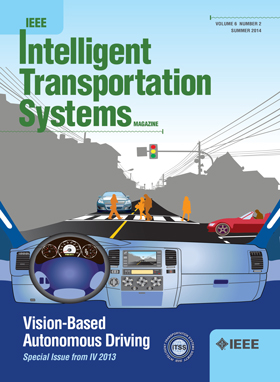Uncovering Passenger-Seeking Behavior of Vacant Taxis From Trajectory Data via Self-Supervised Deep Spectral Clustering
IF 7.9
1区 工程技术
Q1 ENGINEERING, CIVIL
IEEE Transactions on Intelligent Transportation Systems
Pub Date : 2025-03-10
DOI:10.1109/TITS.2025.3546293
引用次数: 0
Abstract
Knowledge of vacant taxis’ passenger-searching behavior is of great social and economic interest to multiple applications, particularly in planning and operating on-demand mobility services. The inherent stochasticity and dynamic nature in both passenger demand and drivers’ decision-making pose challenges in capturing vacant taxis movements. This study proposes a novel deep clustering framework to comprehensively uncover passenger-searching strategies from extensive trajectory data. Specifically, multiple features from vacant searching trips are extracted and analogously defined as multi-channel images, where each channel corresponds to a specific feature. A novel deep image clustering approach is then proposed, integrating a feature representation module utilizing convolutional neural networks (ConvNets), a self-expression module for affinity learning, a spectral clustering module, and a classification module for self-supervision. An effective training procedure is also presented for the proposed deep clustering framework. Experiments demonstrate the effectiveness of the proposed approach against benchmark methods. Based on the clustering results, common and specific passenger searching strategies are further revealed. Specifically, our findings highlight the importance of individual’s contextual experience in explaining searching behavior and operational efficiency. Moreover, drivers cruising without clear searching strategy often exhibit lower performance, and some drivers may gamble with peers to increase their chances of picking up passengers. These results deliver important justifications for future studies and provide managerial implications to improve on-demand mobility.求助全文
约1分钟内获得全文
求助全文
来源期刊

IEEE Transactions on Intelligent Transportation Systems
工程技术-工程:电子与电气
CiteScore
14.80
自引率
12.90%
发文量
1872
审稿时长
7.5 months
期刊介绍:
The theoretical, experimental and operational aspects of electrical and electronics engineering and information technologies as applied to Intelligent Transportation Systems (ITS). Intelligent Transportation Systems are defined as those systems utilizing synergistic technologies and systems engineering concepts to develop and improve transportation systems of all kinds. The scope of this interdisciplinary activity includes the promotion, consolidation and coordination of ITS technical activities among IEEE entities, and providing a focus for cooperative activities, both internally and externally.
 求助内容:
求助内容: 应助结果提醒方式:
应助结果提醒方式:


